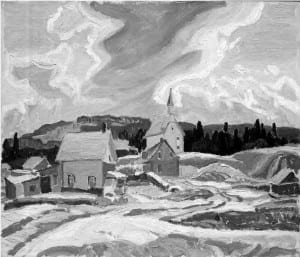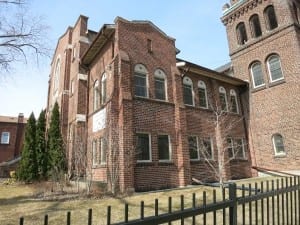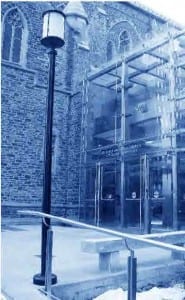Ontario’s heritage places of worship may be characterized as living cultural heritage resources
This blog post concerns Heritage Places of Worship: A Guide to Conserving Heritage Places of Worship in Ontario Communities. As I understand, this is an Ontario Heritage Tool kit document.
You can access the PDF file of the guide by clicking here.
Alternatively you can access the file by clicking on the following link:
Heritage_Tool_Kit_Places_of_Worship
The document is of direct relevance to the Wesley Mimico redevelopment process.

Franklin Carmichael (1890-1945) - Church and Houses at Bisset c.1931G, Gift of the Founders, Robert and Signe McMichael, McMichael Canadian art Collection, 1966.16.11
The Ontario Heritage Act Tool Kit related to Places of Worship includes a reproduction (as indicated above) of a Franklin Carmichael oil painting. The painting communicates the central and in some cases dominant role that a church has played, in the past, in many communities. I like the way that forms are used to create a coherent and integrated sense of movement as the eye travels across the canvas, repeatedly returning to the figure of the church.
Summary of the opening paragraphs
This document, from the Ontario Ministry of Tourism, Culture and Sport, is written in a form of English which in my experience is a challenge to comprehend. Such a text typically gives indication of having gone through a large number of drafts and revisions with the result that the voice – what people like to call the writer’s voice – that is characteristic of much other writing that one encounters is missing, or muffled.
This is perhaps inevitable; I wouldn’t know. At any rate, it’s part of how governments work. The key concern, however, is not the the style of writing. What matters above all is the content of a document, however it may be written.
The content of this heritage places of worship document in my view is highly valuable. For that reason, I will summarize the opening sentences of the document in my own words.
An estimated 12,000 heritage places of worship
According to the opening paragraphs (see below), there are thousands of properties in Ontario, an estimated 12,000 of them that now serve – or have served in the past – as places of worship.
An essential point that’s worth underlining is that very few of these thousands of properties have received formal recognition or protection under the Ontario Heritage Act or by other means. Few have, in other words, been listed or designated as heritage properties.
Such properties face many challenges. Congregations have been getting smaller and costs related to the properties have been rising. The building are getting older and public safety and accessibility issues need to be addressed.
On a positive note, we can add that these properties are of value from the point of view of history, culture, spirituality, and the ongoing life of the communities where the properties are located.
Cultural heritage value
Owners of places of worship have many things to think about – including building upkeep and the desire that people have to be of service to the community. Places of worship – such as churches, mosques, and temples – must also address spiritual concerns, which may change with the passage of time. They must also address what the document describes as “cultural heritage value,” [which is a vague term that is likely to give rise to confusion when a typical reader first encounters it].
The document adds that we can think of churches and other places of worship as “living cultural heritage resources.”
[What this means is not clear from the opening paragraphs. What this term has to do with “the ongoing need to change or adapt […] to new philosophies, doctrines or practices of worship” isn’t clear either.
[How this concept, whatever it means, “should be considered when deciding the best approach to conserving a heritage place of worship” isn’t clear either, but it’s my hope that the rest of the text will help a reader to understand the intended message.]
Update:
[In a subsequent blog post, I note that I’ve arrived at a better understanding of the intended meaning of the expression “living cultural heritage resources.”]
The opening paragraphs of the document read as follows:
Ontario’s heritage places of worship are celebrated and respected as spiritual centres and enduring landmarks in our communities.
An estimated 12,000 properties in Ontario are now or were historically in religious use. Of these, about half remain, and few have formal recognition or protection. Despite their value to individual communities, heritage places of worship are under-represented in the record of Ontario’s protected heritage places.
Today, property owners of heritage places of worship face many challenges. These can include dwindling congregations, shrinking revenues and rising costs, aging building stock, public safety and accessibility, real estate pressures, adapting to new forms of worship and changing attitudes.
At the same time, many heritage places of worship are important to the larger community as resources of cultural heritage value or interest, as well as centres of spirituality and community services.
Property owners often have a difficult task of determining priorities regarding the ongoing care of heritage places of worship, accommodating the evolving practices and religious needs of faith groups, while considering and contributing towards the interests of the broader community.
In most cases, heritage places of worship must cover operating, maintenance and capital investments through a combination of donations, grants and incentives (for religious organization or leased to another charitable organization as a place of worship is exempt from property tax under the Ontario Assessment Act).
Many cultural heritage properties change or are adapted over time, but places of worship may be different in that they often have evolving spiritual values in addition to cultural heritage value. Heritage places of worship may be thought of as “living cultural heritage resources” due to the ongoing need to change or adapt them to new philosophies, doctrines or practices of worship. This should be considered when deciding the best approach to conserving a heritage place of worship.
[End of excerpt from opening paragraphs of the document]
Ontario’s Places of Worship Inventory
The Ontario’s Places of Worship Inventory, launched in 2009, is, as the places of workshop toolkit document notes, “developed to assist property owners and municipalities in planning for the preservation and adaptive reuse of heritage places of worship” (p. 9).

The section of Wesley Mimico United Church that faces Mimico Avenue was completed in 1953. The earlier part of the church, including the bell tower, facing Station Road, was completed in 1922. The bricks in the two sections of the church have slightly colours. Jaan Pill photo
The inventory notes that the architectural design of Wesley Mimico United Church demonstrates a massing typology categorized as irregular/ asymmetrical and a style typology categorized as Italianate.
An irregular/symmetrical massing typology is described as being ‘not easily identifiable as any other style. It is often the result of a built-up series of architecturally contradictory additions or phases.” The church was built in two phases, completed in 1922 and in 1953.
The history details for the church remain to be filled in and/or corrected in the inventory.
Alterations
The document notes (p. 26) that: “Over time, a heritage place of worship may require alterations, either to accommodate changes in religious use or community programs, or to comply with legislated requirements in such areas as public health, safety and accessibility.”

"St. Paul's Anglican Church in Toronto has undertaken renovations that improve building access while remaining sensitive to the heritage structure. (Photo © Ontario Heritage Trust)"
Government of Ontario Heritage Places of Worship document is available online
You can access the complete text by clicking here.

Leave a Reply
Want to join the discussion?Feel free to contribute!